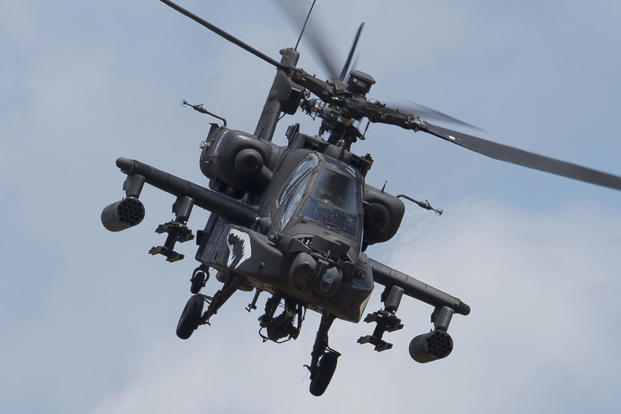Army aviation units are performing an emergency retrofit to its AH-64E Apache helicopters to ensure that rotors don't break off during flight.
Traditionally, the rotor blades are attached to the airframe with eight "strap pack nuts," but aviation officials became concerned earlier this year that bad weather and salt in coastal areas would cause the fasteners to wear out faster, according to an Army news release.
In February, the service's Aviation and Missile Command ordered technicians to perform tedious inspections of the strap nuts before and after flights.
After working with industry, the Army selected a solution known as the "mega-nut," a fail-safe collar that is being installed on two battalions' worth of Apaches per month, according to Maj. Gen. Douglas Gabram, head of the command.
The service is about 19 percent finished with its Apache retrofit, an effort that is scheduled to be complete by next summer, Gabram said.
His comments came at the same Sept. 5 Association of the United States Army aviation event in which Maj. Gen. William Gayler announced that the service intends to fly the Apache for another three decades.
Gayler, who commands the Aviation Center of Excellence and Fort Rucker, Alabama, told an audience that the Cold War-era Apache is still an "incredibly capable aircraft" that the Army plans to fly "well into the ‘40s."
As part of the service's Future Vertical Lift effort, aviation officials are focused on building a new long-range assault aircraft to replace the UH-60 Black Hawk, as well as designing and building a new armed reconnaissance aircraft by 2028.
In 2014, the Army selected two firms to develop demonstrators that could lead to the long-range assault aircraft. Textron Inc.'s Bell Helicopter created the V-280 Valor, which completed its first test flight in December. Sikorsky, part of Lockheed Martin Corp., and Boeing Co. built the SB>1 Defiant, a medium-lift chopper based on Sikorsky's X2 coaxial design.
But currently, the Army has no plans to add an Apache replacement to the Future Vertical Lift program, Gayler said.
As part of its fiscal 2019 budget request, the Army plans to spend $285 million on 12 new AH-64Es and requested $928 million to buy 48 AH-64E remanufactured aircraft.
The requests are in the 2019 National Defense Authorization Act, but a House-Senate working committee has yet to complete work on appropriations for final funding.
-- Matthew Cox can be reached at matthew.cox@military.com.










